There are many men who will tell you that buying an airplane very nearly resulted in divorce because their wives were dead-set against its purchase.
Kenneth Spivey Jr., from Vestavia, Ala., says he had a completely different experience: “My wife actually MADE me go buy this airplane!” he said, gesturing to his 1952 Cessna 170B.
 The airplane is gorgeous, all red and white and chrome with a meticulously detailed interior. But it wasn’t good looks that made it so attractive, said Spivey. It was pure practicality.
The airplane is gorgeous, all red and white and chrome with a meticulously detailed interior. But it wasn’t good looks that made it so attractive, said Spivey. It was pure practicality.
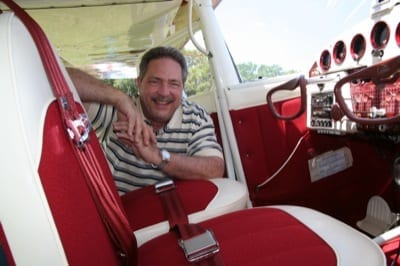 “We needed a bigger airplane to hold our growing family,” he said, noting that aviation is strong in his line. “When I was growing up my Dad had a model airplane manufacturing company. Then when he decided to learn to the fly he bought a Piper Cub.” The elder Spivey also pursued his A&P tickets so he could do his own repairs.
“We needed a bigger airplane to hold our growing family,” he said, noting that aviation is strong in his line. “When I was growing up my Dad had a model airplane manufacturing company. Then when he decided to learn to the fly he bought a Piper Cub.” The elder Spivey also pursued his A&P tickets so he could do his own repairs.
At that point the family was hooked, Spivey reported. He learned to fly with his father. When he was 16 he soloed in a Luscombe 8A that his father had purchased.
Despite this influence, the younger Spivey didn’t want to be an airline pilot. Instead, he earned a college degree in criminal justice and was intent on becoming an air marshal.
“But then President Carter got into office and froze all the federal jobs, so instead I went out to the local airport, became a flight instructor, then a corporate pilot, and now I’m with the FAA,” he said.
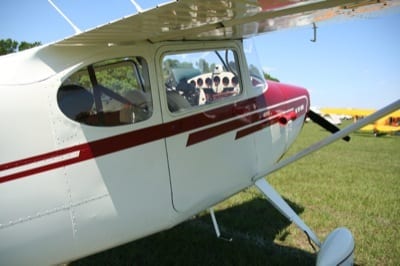 Meanwhile, he continued to fly for fun on the side. He owned a Cessna 140, which he used to court Sylvia, his high school sweetheart. “We flew the Cessna 140 to the Florida beach and back for vacations,” he mused. “It worked out fine until our two sons arrived.”
Meanwhile, he continued to fly for fun on the side. He owned a Cessna 140, which he used to court Sylvia, his high school sweetheart. “We flew the Cessna 140 to the Florida beach and back for vacations,” he mused. “It worked out fine until our two sons arrived.”
The family continued to vacation in Florida, but because the C-140 is a two-place airplane, someone — namely Sylvia —would drive several hours while he flew the children to the beach.
“This went on for a few years, then she figured she was losing out so she told me that we needed a four-place airplane,” said Spivey.
The Cessna 170 series rolled off the assembly line in Wichita from 1948 to 1956. According to Jane’s Encyclopedia of Aviation, 5,173 were built. Art Deco was the style of the day, from the font used for the airplane placards to the shape of the wheel-pants.
The Spivey aircraft looks like it just rolled out of the showroom, although the family has owned it for more than 20 years.
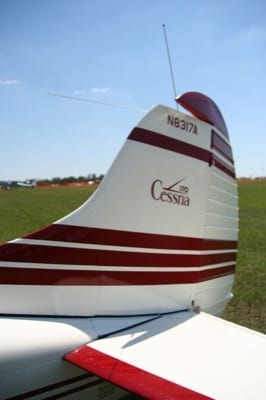 “It’s always been kept in a hangar,” Spivey explained. “I bought it from the second owner who also kept it in a hangar and he bought it from his best friend and he always kept it in a hangar. When I bought it, it had barely 1,000 hours on the airframe. There were about 500 hours on the engine.”
“It’s always been kept in a hangar,” Spivey explained. “I bought it from the second owner who also kept it in a hangar and he bought it from his best friend and he always kept it in a hangar. When I bought it, it had barely 1,000 hours on the airframe. There were about 500 hours on the engine.”
While that’s not a lot of time in the airplane world, upon acquiring the airplane, Spivey put the Cessna into restoration. For two years it was under the control of Bill Stratton Jr. and Harley Pickett, whom Spivey describes as craftsmen of the highest caliber. “The airplane wouldn’t be what it is today without these two!” he said.
The Spivey 170 is painted candy-apple red and off-white. The color is rich and vibrant, but that’s not how they came from the factory, said Spivey.
“It was all natural polished aluminum with red striping,” he said. “We opted to go with the red and off-white because it’s much less work to keep it clean.”
The exterior is done in red and white stripes, from the spinner to the tail. Even the wheel pants feature the detail. The color scheme continues inside the airplane. The headliner is smooth cloth and meticulously clean. The panel instruments, all steam-gauge, are framed in red. The door handles are chrome levers, like the ones you find in vintage cars. The sun visors are hand stitched leather.
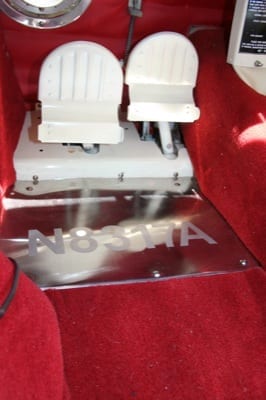 Of particular interest is the kickplate. The aircraft tail-number is etched into it. That detail was a surprise to Spivey.
Of particular interest is the kickplate. The aircraft tail-number is etched into it. That detail was a surprise to Spivey.
“I had been collecting a lot of things over the years knowing that I was going to restore the airplane. I went to a race car fabrication shop and asked them to make me a kickplate out of stainless steel rather than aluminum,” Spivey recalled. “When I went to pick up the airplane they had etched the serial number in the kickplate. People who see that remark that it is a very nice feature of the airplane.”
The instrument panel is pretty much stock, said Spivey, stowing the yoke-mounted GPS he uses as back up when he flies. The flight instruments are positioned across the panel, rather than the so-called “six pack” design that places airspeed, artificial horizon, altimeter, turn and bank, heading indicator and vertical speed indicator right in front of the pilot. Cessna did not go to the familiar six-pack display until the mid-1960s.
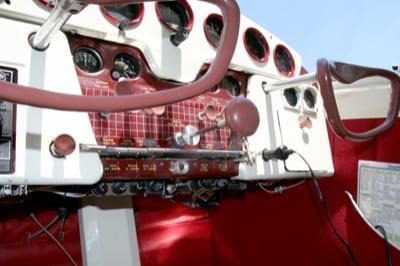 The fuel gauges are mounted in the ceiling, right over the doors rather than on the panel. A placard, done in white over red, warns the pilot against taking off when the fuel is below a certain level. “The airplane originally came with a VOR with a mast antennae and an ADF. We took the antennae off when we did the restoration,” Spivey said.
The fuel gauges are mounted in the ceiling, right over the doors rather than on the panel. A placard, done in white over red, warns the pilot against taking off when the fuel is below a certain level. “The airplane originally came with a VOR with a mast antennae and an ADF. We took the antennae off when we did the restoration,” Spivey said.
I was surprised to see a LORAN in the cockpit. “It is a boat anchor,” Spivey laughed, adding that it will be removed at a later date. For the time being it adds authenticity to the airplane, which was part of Cessna’s efforts to put a flying station wagon in every hangar.
Spivey noted that his sons did not immediately follow him into aviation.
“I think I did them in at an early age,” he said, shaking his head. “I also have my A&P ticket. When they were little and I worked on the Luscombe and the Cessna with my Dad, the boys would be there to hand Daddy tools. When they were still small enough we’d send them down into the tail-cone to clean them out and I think that did them in. Neither one of them wanted a career in aviation, although my younger son, who is 25 now, did just start taking lessons. He has six hours so far. The other one is an artist. He loves to draw the airplane and make sculptures of it.”
People who read this article also read articles on airparks, airshow, airshows, avgas, aviation fuel, aviation news, aircraft owner, avionics, buy a plane, FAA, fly-in, flying, general aviation, learn to fly, pilots, Light-Sport Aircraft, LSA, and Sport Pilot.
